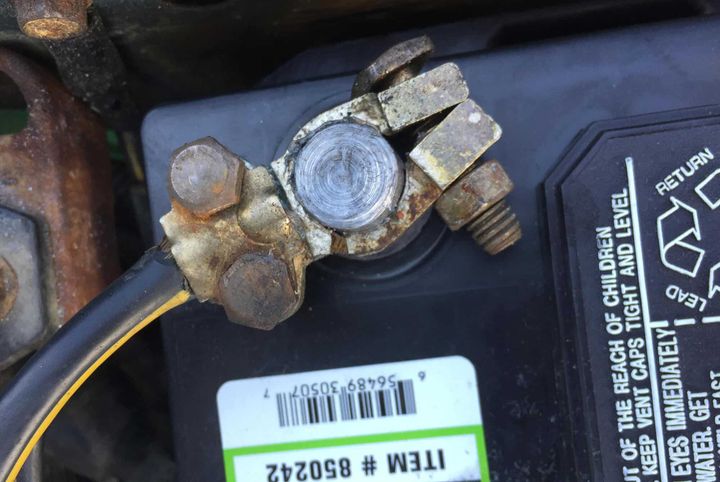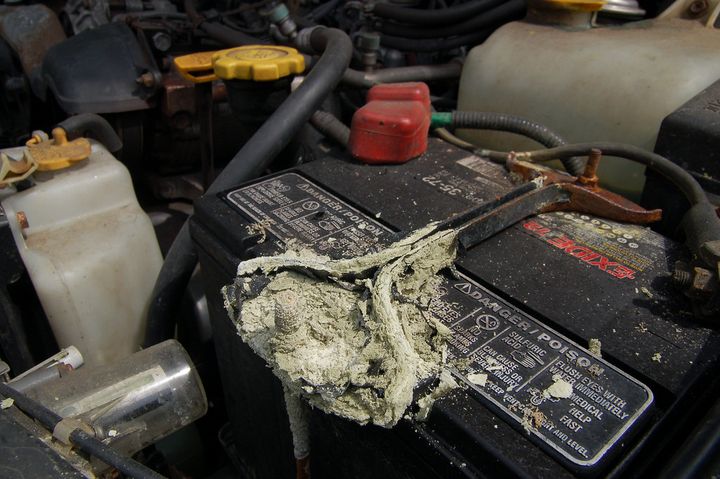


The battery is a crucial component in a vehicle's electrical system, providing the necessary power to start the engine and run various electrical components. Over time, battery terminals can corrode or become loose, leading to various issues that can affect the overall performance and reliability of the vehicle. Recognizing the signs of bad battery terminals is essential for addressing the problem promptly and preventing further complications.

Before we dive into the symptoms, let's first understand the main culprits behind battery terminal woes. Corrosion buildup is undoubtedly the most common offender. This crusty deposit, which can appear white, blue, or green, acts as an insulating layer, preventing proper electrical flow between the battery and cables. It's like putting a thick blanket over your battery, suffocating its ability to power your vehicle.
| Cause | Description |
|---|---|
| Corrosion Buildup | Crusty deposits on terminals, acting as an insulator |
| Loose Connections | Terminals or cables not tightly secured, disrupting electrical flow |
| Physical Damage | Cracks, breaks, or fraying in terminals or cables |
Another frequent issue is loose or damaged terminal connections. Imagine trying to power your car with a frayed extension cord – it just won't work efficiently. Cracks, breaks, or looseness in the terminals or cables can disrupt the crucial electrical connection, leaving your battery struggling to do its job.
Now that we know the enemies, let's learn how to identify their presence. One of the most obvious signs is visible corrosion buildup on the battery terminals. If you see those crusty deposits, it's a clear red flag. Additionally, try wiggling the terminals and cable connectors – they should be tightly secured with no movement whatsoever.
| Symptom | Possible Cause |
|---|---|
| Visible Corrosion | Corrosion buildup on terminals |
| Loose Connections | Terminals or cables not tightly secured |
| Dimming Lights/Accessories | Voltage drop due to poor connections |
| Starting Issues | Poor electrical flow from battery |
| Warning Lights | Electrical system malfunctions |
Another telltale symptom is dimming headlights or electrical accessories when you rev the engine. This could indicate a voltage drop caused by poor connections. You might also notice that your car struggles to start or experiences electrical issues like warning lights or malfunctioning components.
As a mechanic, I always recommend a thorough inspection to pinpoint the exact issue. Start by visually examining the battery terminals and cables for any signs of corrosion, looseness, or physical damage. Use a flashlight and mirror to inspect hard-to-see areas, and don't be afraid to get up close and personal.
Then, grab your trusty multimeter and check for voltage drop across the terminals and connections when the engine is running. Excessive voltage drop is a surefire indicator of a poor connection. Here's a quick guide on how to perform this test:
Connect the positive multimeter lead to the positive battery terminal.
Connect the negative multimeter lead to the negative battery terminal.
Start the engine and let it idle.
Check the voltage reading on the multimeter.
| Voltage Drop | Interpretation |
|---|---|
| Less than 0.5V | Good connection |
| 0.5V - 1.0V | Marginal connection, monitor closely |
| More than 1.0V | Poor connection, needs repair |
If the voltage drop exceeds 1.0V, it's a clear sign that you need to address the issue promptly.
Now comes the fun part – rolling up our sleeves and getting our hands dirty! If you've identified corrosion buildup, disconnect the battery and grab a wire brush and some baking soda mixed with water. Scrub those terminals until they're shining like new, then dry them thoroughly before reconnecting.
For loose connections, it's as simple as tightening the terminal connectors using the proper tools until they're snug and secure, with no wiggle room. Here are the recommended torque values for common battery terminal sizes:
| Terminal Size | Torque Value |
|---|---|
| 5/16" | 60-100 in-lbs (6.8-11.3 N-m) |
| 3/8" | 120-180 in-lbs (13.6-20.3 N-m) |
| 7/16" | 180-240 in-lbs (20.3-27.1 N-m) |
If the terminals or cables themselves are cracked, broken, or excessively worn, it's time for a replacement. Don't skimp on this – using damaged components can lead to further issues down the road. When replacing cables, ensure you use the correct gauge and length for your vehicle's specifications.
An ounce of prevention is worth a pound of cure, as they say. Regular battery and cable inspections should be part of your routine maintenance routine. Here's a quick checklist for preventive maintenance:
Visually inspect terminals and cables for corrosion, looseness, or damage
Clean any corrosion buildup promptly
Apply a thin coating of dielectric grease or battery terminal protector
Ensure terminals and connections are properly tightened
Replace old batteries and cables before they fail
It's also a good idea to keep a few essential tools in your car for quick fixes:
| Tool | Purpose |
|---|---|
| Wire Brush | Cleaning corrosion |
| Baking Soda | Neutralizing acid from corrosion |
| Dielectric Grease | Protecting terminals from future corrosion |
| Wrench Set | Tightening loose connections |
By being proactive and addressing issues early, you can avoid more significant problems and costly repairs down the line.

Now, let's talk about the elephant in the room – the cost of repairs. Cleaning corroded terminals can be relatively inexpensive, with supplies like a wire brush, baking soda, and grease costing around $10 to $50. If you're not comfortable doing it yourself, expect to pay $20 to $50 in labor fees at a mechanic's shop.
Tightening loose connections is usually a straightforward job, with labor costs ranging from $20 to $50 if done by a professional.
Replacing battery terminals or cables can get a bit pricier. New terminals can cost $5 to $20, plus $20 to $50 in labor. As for cables, you're looking at $30 to $150 for the parts, plus $50 to $100 in labor charges.
| Repair | Parts Cost | Labor Cost |
|---|---|---|
| Clean Terminals | $10 - $50 | $20 - $50 |
| Tighten Connections | - | $20 - $50 |
| Replace Terminals | $5 - $20 | $20 - $50 |
| Replace Cables | $30 - $150 | $50 - $100 |
While DIY repairs can save you money on labor, always prioritize safety when working on car batteries. If you're unsure or dealing with severe corrosion or damage, it's best to leave it to the professionals to avoid further complications.
There you have it, folks – a comprehensive guide to recognizing and tackling bad battery terminal symptoms from a seasoned mechanic's perspective. Remember, a little preventive maintenance can go a long way in keeping your car's electrical system running smoothly. Don't ignore those warning signs, and always prioritize safety when working on your vehicle.
Happy motoring, and may your battery terminals stay corrosion-free and tightly connected!
The main cause of battery terminal corrosion is a chemical reaction between the battery's acidic fumes or leaks and the metal terminals. Hydrogen gas released from the battery also contributes to corrosion buildup.
Look for crusty white, blue, or green deposits around the battery terminals and cable connectors. Corrosion buildup is usually easy to spot with the naked eye.
You'll need a wire brush, baking soda, water, and protective gear like gloves and safety glasses. A multimeter can also help diagnose voltage drop issues.
Yes, loose terminals disrupt the electrical connection, leading to issues like dimming lights, starting problems, and warning lights on the dashboard.
Connect a multimeter's positive lead to the positive terminal and negative lead to the negative terminal. Start the engine and check the voltage reading while idling.
A voltage drop of less than 0.5V is considered good, 0.5V to 1.0V is marginal, and anything above 1.0V indicates a poor connection that needs repair.
Regular inspections should be part of your routine maintenance schedule. Check for corrosion, looseness, or damage at least every few months or as recommended by the manufacturer.
Yes, applying a thin coating of petroleum jelly or dielectric grease can help prevent future corrosion by protecting the terminals from moisture and acid fumes.
If the cables are cracked, broken, excessively worn, or causing significant voltage drop, it's time to replace them with new cables of the correct gauge and length.
Working on batteries can be dangerous due to the risk of electric shock and exposure to acid. If you're unsure or dealing with severe corrosion, it's best to have a professional mechanic handle the repairs.

Sarah isn't your average gearhead. With a double major in Mechanical Engineering and Automotive Technology, she dived straight into the world of car repair. After 15 years of turning wrenches at dealerships and independent shops, Sarah joined MICDOT to share her expertise and passion for making cars run like new. Her in-depth knowledge and knack for explaining complex issues in simple terms make her a valuable asset to our team.














